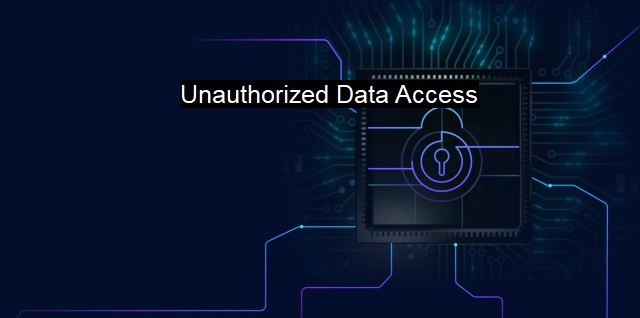What are Unauthorized Data Access?
Defending Your Data: A Comprehensive Guide to Understanding and Preventing Unauthorized Data Access in Cybersecurity and Antivirus
Unauthorized data access is a major concern pertaining to the illegal and unsolicited invasion of a target's digital privacy and the procurement of their personal, confidential data without their prior consent or knowledge. This concept is central to the unique milieu of cybersecurity, which seeks to build a robust defense against this illicit affinity for unauthorized data breaches.Unauthorized data access predominantly arises from bad actors or hackers exploiting weaknesses in a system's underlying security framework. These incursions can lead to serious consequences, with repercussions extending from intellectual property breaches, financial fraud, and if it's a larger corporation, potentially disrupting the local or even global economy.
A fundamental misunderstanding persists among many people that unauthorized data access only pertains to the sphere of malware attacks or infecting hardware infrastructures. software vulnerabilities or faults in the security policies, including user negligence, can also lead to unauthorized data access. If security vulnerabilities within applications or networks are not resolved with patches, they leave space for cybercriminals to exploit and gain access to confidential data.
It's equally important to comprehend that unauthorized data access is not always an overt action. Sophisticated breaches may encompass covert tactics – stealthily mining personal information in the background, often without an obvious, perceptible invasion, making it a silent threat.
Let's move onto the more adverse consequences inflicted by unauthorized data access. Stolen data can be utilized directly for profit, as seen during identity theft, where specific, personally identifiable details are used to facilitate actions like loan fraud. Subsequently, the victims undergo financial losses and social defame until their innocence is proven. Breached business secrets, say in the pharmaceutical industry, may lead to heavy financial losses. It doesn't just end with an economic downfall; information leaked could result in drastic harmful social repercussions.
Given the significance and potential impact of unauthorized data access, cybersecurity firms heavily invest in innovating advanced solutions. Antivirus software plays a critical role in this battlefront, providing preventive defence measures by appraising incoming data for malicious signatures that can potentially damage the system.
Antivirus works with the presumption that any interaction, application or user's habits may contain potential threats leading to unauthorized data access. With heuristic-based detection or monitoring of user behavior, potential threats are scrutinized and quarantined or eliminated based on the analysis.
In any battle, the adversary too develops with each offence. In this cyber-war, malware continually evolves to penetrate layers of defenses tactically. Hence, cybersecurity solutions are designed to continuously adapt. Cybersecurity professionals work incessantly towards patching newly identified vulnerabilities, updating systems, and taking proactive measures to thwart unauthorized data access attempts.
To further fortify defences against unauthorized data access, multi-factor authentication and data encryption techniques are widely deployed. Multi-factor authentication, by necessity, mandates the availability of two or more pieces of evidence via diverse categories before access can be granted, potentiate the barriers unauthorized parties face before eventually breaching security. Data encryption translates the information into a sophisticated code, which couldn't be deciphered and utilized without access to a secret decryption key.
Reliant as we may be on technology to safeguard against the scourge of unauthorized data access, human vigilance too has a definitive part to play. Practices such as regular software updates, strong and diverse password use, avoiding suspicious emails or software, and adequate staff training can aidsignificantly in fortifying defences.
In the final analysis, one can't afford to give unauthorized data access an afterthought, given the high cost and deleterious consequences of complacence. Concerted efforts from individuals, organizations, and the cybersecurity industry as a whole are necessary, translating into a rigorous, evolved, and continuously adaptive defense system to counter the menace of unauthorized data access.

Unauthorized Data Access FAQs
What is unauthorized data access in the context of cybersecurity?
Unauthorized data access refers to the act of accessing, stealing, manipulating, or destroying sensitive information without the owner's consent, authorization, or knowledge. It is a cybersecurity breach that can cause severe damage and loss to individuals, organizations, and systems.What are the common causes or methods of unauthorized data access?
The common causes or methods of unauthorized data access include phishing attacks, malware infections, weak passwords, unsecured networks or devices, social engineering, insider threats, and software vulnerabilities.What are the consequences or impacts of unauthorized data access?
The consequences or impacts of unauthorized data access can vary from financial losses, reputational damage, legal liabilities, intellectual property theft, identity theft, to regulatory non-compliance. It can also compromise the confidentiality, integrity, and availability of data, leading to service disruptions, system failures, or cyber espionage.How can antivirus software help prevent unauthorized data access?
Antivirus software can help prevent unauthorized data access by detecting and removing malware, viruses, or other malicious software that can compromise the security of a system. It can also offer real-time protection against phishing attempts, suspicious links or downloads, and other cyber threats. However, antivirus software alone cannot guarantee 100% protection against unauthorized data access, and users should also adopt good cybersecurity practices and habits, such as using strong passwords, updating software regularly, and being vigilant of suspicious activities.| | A | | | B | | | C | | | D | | | E | | | F | | | G | | | H | | | I | | | J | | | K | | | L | | | M | |
| | N | | | O | | | P | | | Q | | | R | | | S | | | T | | | U | | | V | | | W | | | X | | | Y | | | Z | |
| | 1 | | | 2 | | | 3 | | | 4 | | | 7 | | | 8 | | |||||||